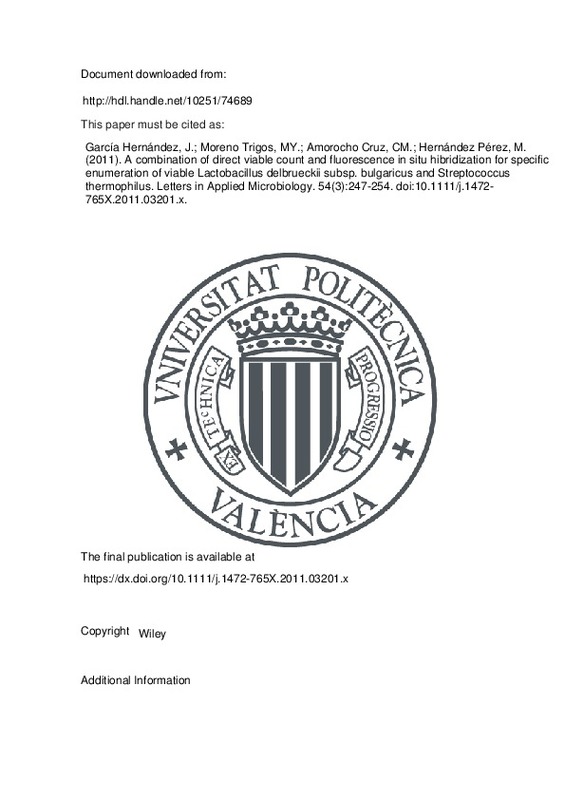JavaScript is disabled for your browser. Some features of this site may not work without it.
Buscar en RiuNet
Listar
Mi cuenta
Estadísticas
Ayuda RiuNet
Admin. UPV
A combination of direct viable count and fluorescence in situ hibridization for specific enumeration of viable Lactobacillus delbrueckii subsp. bulgaricus and Streptococcus thermophilus
Mostrar el registro sencillo del ítem
Ficheros en el ítem
| dc.contributor.author | García Hernández, Jorge
|
es_ES |
| dc.contributor.author | Moreno Trigos, Mª Yolanda
|
es_ES |
| dc.contributor.author | Amorocho Cruz, Claudia Milena
|
es_ES |
| dc.contributor.author | Hernández Pérez, Manuel
|
es_ES |
| dc.date.accessioned | 2016-11-29T07:49:26Z | |
| dc.date.available | 2016-11-29T07:49:26Z | |
| dc.date.issued | 2011-03 | |
| dc.identifier.issn | 0266-8254 | |
| dc.identifier.uri | http://hdl.handle.net/10251/74689 | |
| dc.description.abstract | [EN] Aims: We have developed a direct viable count (DVC)-FISH procedure for quickly and easily discriminating between viable and nonviable cells of Lactobacillus delbrueckii subsp. bulgaricus and Streptococcus thermophilus strains, the traditional yogurt bacteria. Methods and Results: direct viable count method has been modified and adapted for Lact. delbrueckii subsp, bulgaricus and Strep. thermophilus analysis by testing different times of incubation and concentrations of DNA-gyrase inhibitors. DVC procedure has been combined with fluorescent in situ hybridization (FISH) for the specific detection of viable cells of both bacteria with specific rRNA oligonucleotide probes (DVC-FISH). Of the four antibiotics tested (novobiocin, nalidixic acid, pipemidic acid and ciprofloxacin), novobiocin was the most effective for DVC method and the optimum incubation time was 7 h for both bacteria. The number of viable cells was obtained by the enumeration of specific hybridized cells that were elongated at least twice their original length for Lactobacillus and twice their original size for Streptococcus. Conclusions: This technique was successfully applied to detect viable cells in inoculated faeces. Significance and Impact of the Study: Results showed that this DVC-FISH procedure is a quick and culture-independent useful method to specifically detect viable Lact, delbrueckii subsp, bulgaricus and Strep thermophilus in different samples, being applied for the first time to lactic acid bacteria. | es_ES |
| dc.language | Inglés | es_ES |
| dc.publisher | Wiley | es_ES |
| dc.relation.ispartof | Letters in Applied Microbiology | es_ES |
| dc.rights | Reserva de todos los derechos | es_ES |
| dc.subject | Direct viable count | es_ES |
| dc.subject | FISH | es_ES |
| dc.subject | Lactobacillus delbrueckii subsp | es_ES |
| dc.subject | Bulgaricus | es_ES |
| dc.subject | Rapid method | es_ES |
| dc.subject | Streptococcus thermophilus | es_ES |
| dc.subject.classification | MICROBIOLOGIA | es_ES |
| dc.title | A combination of direct viable count and fluorescence in situ hibridization for specific enumeration of viable Lactobacillus delbrueckii subsp. bulgaricus and Streptococcus thermophilus | es_ES |
| dc.type | Artículo | es_ES |
| dc.identifier.doi | 10.1111/j.1472-765X.2011.03201.x | |
| dc.rights.accessRights | Abierto | es_ES |
| dc.contributor.affiliation | Universitat Politècnica de València. Departamento de Biotecnología - Departament de Biotecnologia | es_ES |
| dc.contributor.affiliation | Universitat Politècnica de València. Instituto Universitario de Ingeniería del Agua y del Medio Ambiente - Institut Universitari d'Enginyeria de l'Aigua i Medi Ambient | es_ES |
| dc.description.bibliographicCitation | García Hernández, J.; Moreno Trigos, MY.; Amorocho Cruz, CM.; Hernández Pérez, M. (2011). A combination of direct viable count and fluorescence in situ hibridization for specific enumeration of viable Lactobacillus delbrueckii subsp. bulgaricus and Streptococcus thermophilus. Letters in Applied Microbiology. 54(3):247-254. doi:10.1111/j.1472-765X.2011.03201.x | es_ES |
| dc.description.accrualMethod | S | es_ES |
| dc.relation.publisherversion | https://dx.doi.org/10.1111/j.1472-765X.2011.03201.x | es_ES |
| dc.description.upvformatpinicio | 247 | es_ES |
| dc.description.upvformatpfin | 254 | es_ES |
| dc.type.version | info:eu-repo/semantics/publishedVersion | es_ES |
| dc.description.volume | 54 | es_ES |
| dc.description.issue | 3 | es_ES |
| dc.relation.senia | 210888 | es_ES |







![[Cerrado]](/themes/UPV/images/candado.png)

